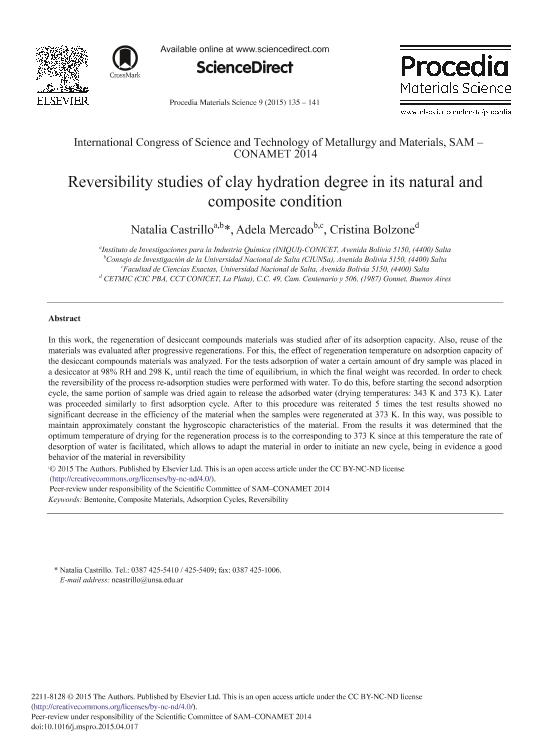Mostrar el registro sencillo del ítem
dc.contributor.author
Castrillo, Natalia Paola

dc.contributor.author
Mercado, Adela Isabel Guadalupe

dc.contributor.author
Volzone, Cristina

dc.date.available
2018-06-18T20:58:06Z
dc.date.issued
2015-04
dc.identifier.citation
Castrillo, Natalia Paola; Mercado, Adela Isabel Guadalupe; Volzone, Cristina; Reversibility Studies of Clay Hydration Degree in its Natural and Composite Condition; Elsevier Science; Procedia Materials Science; 9; 4-2015; 135-141
dc.identifier.issn
2211-8128
dc.identifier.uri
http://hdl.handle.net/11336/49163
dc.description.abstract
In this work, the regeneration of desiccant compounds materials was studied after of its adsorption capacity. Also, reuse of the materials was evaluated after progressive regenerations. For this, the effect of regeneration temperature on adsorption capacity of the desiccant compounds materials was analyzed. For the tests adsorption of water a certain amount of dry sample was placed in a desiccator at 98% RH and 298 K, until reach the time of equilibrium, in which the final weight was recorded. In order to check the reversibility of the process re-adsorption studies were performed with water. To do this, before starting the second adsorption cycle, the same portion of sample was dried again to release the adsorbed water, using temperatures of 343 K and 373 K. Later was proceeded similarly to first adsorption cycle. After to this procedure was reiterated 5 times the test results showed no significant decrease in the efficiency of the material when the samples were regenerated at 373 K. In this way, was possible to maintain approximately constant the hygroscopic characteristics of the material. From the results it was determined that the optimum temperature of drying for the regeneration process is to the corresponding to 373 K since at this temperature the rate of desorption of water is facilitated, which allows to adapt the material in order to initiate an new cycle, being in evidence a good behavior of the material in reversibility.
dc.format
application/pdf
dc.language.iso
eng
dc.publisher
Elsevier Science

dc.rights
info:eu-repo/semantics/openAccess
dc.rights.uri
https://creativecommons.org/licenses/by-nc-nd/2.5/ar/
dc.subject
Bentonite
dc.subject
Composite Materials
dc.subject
Adsorption Cycles
dc.subject
Reversibility
dc.subject.classification
Recubrimientos y Películas

dc.subject.classification
Ingeniería de los Materiales

dc.subject.classification
INGENIERÍAS Y TECNOLOGÍAS

dc.title
Reversibility Studies of Clay Hydration Degree in its Natural and Composite Condition
dc.type
info:eu-repo/semantics/article
dc.type
info:ar-repo/semantics/artículo
dc.type
info:eu-repo/semantics/publishedVersion
dc.date.updated
2018-06-18T13:29:48Z
dc.journal.volume
9
dc.journal.pagination
135-141
dc.journal.pais
Países Bajos

dc.journal.ciudad
Amsterdam
dc.description.fil
Fil: Castrillo, Natalia Paola. Consejo Nacional de Investigaciones Científicas y Técnicas. Centro Científico Tecnológico Conicet - Salta. Instituto de Investigaciones para la Industria Química. Universidad Nacional de Salta. Facultad de Ingeniería. Instituto de Investigaciones para la Industria Química; Argentina. Consejo de Investigación de la Universidad Nacional de Salta; Argentina
dc.description.fil
Fil: Mercado, Adela Isabel Guadalupe. Consejo de Investigación de la Universidad Nacional de Salta; Argentina. Universidad Nacional de Salta. Facultad de Ciencias Exactas; Argentina
dc.description.fil
Fil: Volzone, Cristina. Provincia de Buenos Aires. Gobernación. Comisión de Investigaciones Científicas. Centro de Tecnología de Recursos Minerales y Cerámica. Consejo Nacional de Investigaciones Científicas y Técnicas. Centro Científico Tecnológico Conicet - La Plata. Centro de Tecnología de Recursos Minerales y Cerámica; Argentina
dc.journal.title
Procedia Materials Science

dc.relation.alternativeid
info:eu-repo/semantics/altIdentifier/doi/https://dx.doi.org/10.1016/j.mspro.2015.04.017
dc.relation.alternativeid
info:eu-repo/semantics/altIdentifier/url/https://www.sciencedirect.com/science/article/pii/S2211812815000188
Archivos asociados
